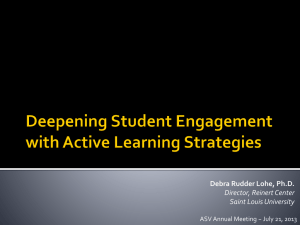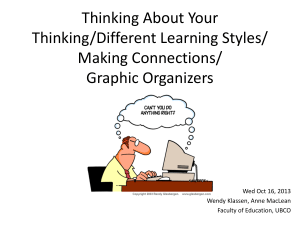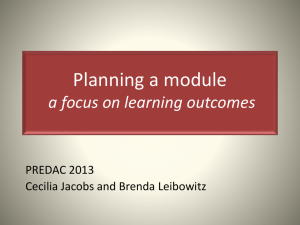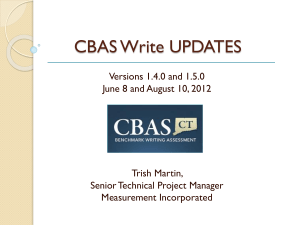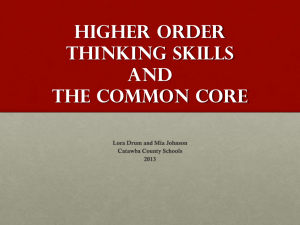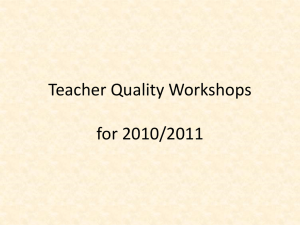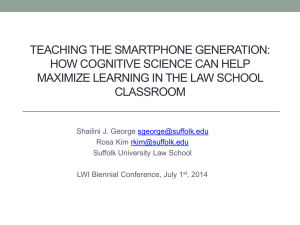File - Growth as a Learner and an Educator
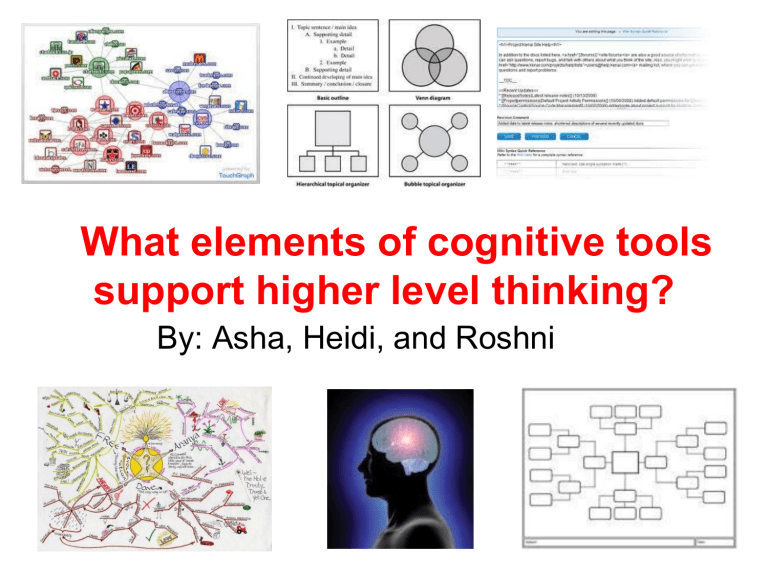
What elements of cognitive tools support higher level thinking?
By: Asha, Heidi, and Roshni
Cognitive Tools
Jonassen and Reeves (1996) define cognitive tools as ‘‘technologies that enhance the cognitive powers of human beings during thinking, problem solving, and learning” (as cited in Kim
& Reeves, 2007, p. 209).
Defining Higher Order Thinking
Higher-order thinking is non-algorithmic, complex, yields multiple solutions, requires the application of multiple criteria, self-regulation, and often involves uncertainty. (Resnick, 1987)
According to (Bloom, Krathwohl, & Masia, 1956) thinking skills can be differentiated into six types: knowledge, comprehension, application, analysis, synthesis, and evaluation.
The revised Bloom’s taxonomy has two dimensions (Anderson & Krathwohl,
2001) knowledge dimension (factual, conceptual, procedural, and metacognitive) and cognitive dimension(remembering, understanding, applying, analyzing, evaluating, and creating).
The higher order thinking skills found on the upper levels of Bloom's taxonomy involves comparing, organizing questions, logical reasoning, analyzing arguments, testing hypotheses, making decisions, estimating likelihoods, designing and constructing new pattern or structure. (Anderson & Krathwohl,
2001)
Bloom's Taxonomy And Higher Order
Thinking http://www.odu.edu/educ/roverbau/Bloom/blooms_taxonomy.htm
Benefits of Cognitive Tools
According to Shim and Li (2006),
Lajoie (1993, p. 261) summarized that cognitive tools can benefit learners by serving the functions as follows:
1. Support cognitive processes, such as, memory and metacognitive processes
2. Share the cognitive load by providing support for lower level cognitive skills so that resources are left over for higher order thinking skills
3. Allow the learners to engage in cognitive activities that would be out of their reach otherwise
4. Allow learners to generate and test hypotheses in the context of problem solving
Types of Cognitive Tools
Liyoshi, Hannafin and Wang (2005) categorize cognitive tools according to their functions:
1. Information Seeking Tools
2. Information Presentation Tools
3. Knowledge Organization Tools
4. Knowledge Integration Tools
5. Knowledge Generation Tools
Theories
•
Constructivist Learning Theories
("Learningtheories.com")
•
Cognitive Load Theory
(Ozcelik & Yildirim, 2005)
•
Information Processing Theory
(Ozcelik & Yildirim,
2005)
Graphic Organizers
•
Graphic organizers can be used to promote the higher order thinking skills.
•
The metacognitive skills involved in completing a graphic organizer are the basis for high quality independent practice.
•
Graphic organizers are the vehicles by which metacognitive strategy instruction is delivered in order to aid in comprehension of nonfiction texts.
•
A student's ability to identify similarities and differences through comparing and contrasting, classifying, constructing metaphors and analogies enhances students' understanding of and ability to use knowledge
•
Using graphic organizers to compare, classify, create metaphors and analogies, would allow the teacher to assess the students' skills in comprehending.
•
Because graphic organizers are visual representations of the information contained in the texts, students are better able see and understand relationships among concepts.
Higher Order Thinking
Skill: Compare and Contrast
•
Compare: asking students to identify the details that show how 2 or more ideas/concepts/items are alike, what are the commonalities.
•
Contrast: asking the students to identify how 2 or more ideas/concepts/items are different, the dissimilarities.
•
Graphic organizers used for the higher order thinking skill of comparing and contrasting: o o o
Comparison Matrix
Frayer Model
Continuum Spectrum
Higher Order Thinking Skill:
Classifying
•
Being able to classify objects or ideas is a higher order thinking skill that requires students to manipulate information and ideas in order to reach a deeper understanding of their meaning and implications.
•
Graphic organizers used for the higher order thinking skill of: o o o
Tree Branching
T- Chart
Concept Map
Higher Order Thinking Skill:
•
•
Creating Metaphors
Metaphors help challenge students to use higher level thinking skills to construct deeper understanding.
•
Being able to justify the connections made encourages students to be more creative in their thinking and to verbalize the comparisons.
•
Graphic organizers for the higher order thinking skill of creating metaphors:: o Three Column Chart o T-Chart o Flow Chart
Higher Order Thinking Skill:
Creating Analogies
•
Analogies are used to reveal the relationships between
2 unrelated objects or ideas. •
Analogies are a great way to improve analytical thinking as they require the student to look create and look for relationships between familiar and new concepts.
•
Graphic organizers for higher order thinking skills of creating analogies: o X is to Y as A is to B o Bridge Map o Web Organizer
Conclusion
According to Kim and Reeves (2007), “the results of the cognitive activities of learners should be the consequences of constructing knowledge ‘‘with’’ computer tools rather than learning ‘‘from’’ computer tutorials in a manner previously structured by someone else.”
Reference
Anderson, L. W., & Krathwohl, D. R. (Eds.). (2001). A taxonomy for learning, teaching and assessing: A revision of Bloom's Taxonomy of educational objectives: Complete edition, New York : Longman.
Bloom, S.B., Krathwohl, D.R., & Masia, B.B. (1956). Taxonomy of educational objectives:The classification of educational goals. New York: Longmans.
Kim, B. & Reeves, R. C. (2007). Reframing research on learning with technology: in search of the meaning of cognitive tools. Instructional Science , 35(3), 207-256.
Learning-theories.com - knowledge base and webliography . (n.d.). Retrieved from http://www.learningtheories.com/
Ozcelik, E. & Yildirim, S. (2005). Factors influencing the use of cognitive tools in web-based learning environments: A case study. The Quarterly Review of Distance Education, 6(4), 295 –308.
Resnick, L.B. (1987). Education and learning to think. Washington, DC: National Academy Press.
Shim, J. E., & Li, Y. (2006). Applications of Cognitive Tools in the Classroom. In M. Orey (Ed.), Emerging perspectives on learning, teaching, and technology. Retrieved <insert date>, from http://projects.coe.uga.edu/epltt/
Suarez, K. (2011). Graphic Organizers and Higher Order Thinking Skills with Nonfiction Text . Walden University


